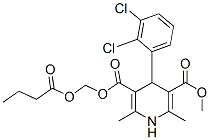| Cleviprex |
|
| (CAS 167221-71-8) |
 |
| Description: |
Clevidipine(Clevidipine) is a short-acting dihydropyridine calcium channel antagonist (IC50= 7.1 nM, V(H) = -40 mV ) under development for treatment of perioperative hypertension.
IC50 Value: 7.1 nM at V(H) = -40 mV [1]
Target: calcium channel
in vitro: Both clevidipine and nitroglycerin completely reversed U46619-induced contraction (clevidipine (50% effective concentration [EC50] = 3.88 +/- 0.84 x 10(-6) mol/L, nitroglycerin EC50 = 4.84 +/- 2.76 x 10(-8) mol/L) [2]. A decrease in temperature increased the half-life of clevidipine in blood, whereas dilution of the blood did not affect the in vitro half-life of clevidipine. The albumin concentration affected the hydrolysis rate of clevidipine in RBC suspended with saline [3].
in vivo: Clevidipine is a high-clearance drug with a relatively small volume of distribution, resulting in an extremely short half-life in all species studied. The median initial half-life of the individual value (Bayesian estimates) is 12, 20, and 22 s in the rabbit, rat, and dog, respectively [4]. The extremely high clearance value and the small volume of distribution resulted in short half-lives of clevidipine, 2.2 and 16.8 min, respectively. The blood concentration and dose rate producing half the maximal effect (i.e. EC50 and ED50) were approximately 25 nM and 1.5 microg/kg/min, respectively [5].
Clinical trial: CARVE: Clevidipine for Vasoreactivity Evaluation of the Pulmonary Arterial Bed. Phase 4
|
| Product No. |
KT20846 |
| Product Name |
Cleviprex |
| Synonyms |
|
| Formal Name |
|
| CAS Number |
167221-71-8 |
| Molecular Formula |
C21H23Cl2NO6 |
| Formula Weight |
456.32 |
| Formulation |
A crystalline solid |
| Purity |
98%min |
| Stability |
2 years |
| Storage |
-20°C |
| Shipping |
USD45 for Europe and USA. No shipping charge once amount reach USD500 |
| Quality Control |
HNMR,CNMR,LCMS,HPLC,IR,etc. |
| Price & Availability |
In Stock. Price Negotiated. |
|
| Related Products: |
Acetylcholine chloride
Acetylcholine is a neurotransmitter that can induce the opening of calcium channels.
Target: Calcium Channel; nAChR; mAChR
Acetylcholine in vertebrates is the major transmitter at neuromuscular junctions, autonomic ganglia, parasympathetic effector junctions, a subset of sympathetic effector junctions, and at many sites in the central nervous system. It is generally not used as an administered drug because it is broken down very rapidly by cholinesterases, but it is useful in some ophthalmological applications.
Acetylcholine chloride, more commonly referred to as just acetylcholine, is a cholinergic neurotransmitter that can induce the opening of calcium channels, as well as act on nicotinic and muscarinic acetylcholine receptors. Acetylcholine plays an important role at many sites in the central nervous system. The compound has been shown to have ophthalmological uses and can be broken down quickly by choliesterases. Studies show that non-neuronal acetylcholine influences many basic cells functions, such as mitosis, cells differentiation, cytoskeletal organization, and cell to cell contact, among other functions [1-3].
|
|


